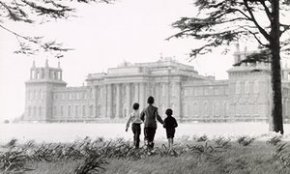British Baroque
 Duke of Marlborough's Grandchildren at Blenheim Palace. Photograph: Lichfield/Lichfield/Getty Images
Duke of Marlborough's Grandchildren at Blenheim Palace. Photograph: Lichfield/Lichfield/Getty Images
In 1660, the Stuart court that returned from the continent with Charles II brought more than restoration, merriment and a yearning for the old ways. It brought a taste for Dutch and French architecture. The English Renaissance, begun haltingly under Queen Elizabeth, reborn under Inigo Jones but repressed during the interregnum, now found its feet.
It was not easy. The mannerist classicism of the Jacobean era was still associated with "old England", largely in decoration. Medieval halls and gabled roofs were still being erected or adapted by landed gentry into the 1660s. But people who had spent two decades in the palaces of Paris and The Hague returned to estates that had seen little renewal in half a century. The zest for the new was irresistible.
First off the blocks was the Earl of Craven, who built ostentatious Ashdown House in the Berkshire Downs for Charles I's sister. A tall, symmetrical building, with wide eaves and a cupola – utterly Dutch. It was a style that came to be known variously as Restoration, William-and-Mary and Queen Anne.
Charles II was determined to match his French counterpart, Louis XIV, in extravagant ambition. In addition to royal palaces already built or under construction at Richmond, Whitehall and Greenwich, new ones were planned for Kensington and, Charles's answer to Versailles, Winchester. Where the king built, his court expected to follow.
Charles's presiding genius was the mathematician, scientist and polymath Sir Christopher Wren. Wren was already planning the rebuilding of the gothic St Paul's Cathedral when, in 1666, it was destroyed in the Great Fire of London. His design for its replacement illustrates the ambivalence of the English Restoration: a classical Renaissance base topped by mildly baroque west towers and dome, designed to float across the rooftops of London.
By then, sumptuous court mansions were dotting the English countryside, either new (such as those at Belton, Dyrham, Eltham and Uppark) or conversions (such as Ham on the Thames near Richmond). These houses, while big, were domestic in character. They respected the understatement of their Dutch models. It was as if the Restoration could not quite shake off the puritanism of the Commonwealth.
Greater flamboyance came from France. At Boughton (1678) in Northamptonshire, the Duke of Montagu converted a medieval hall house into a grand Parisian chateau set in splendid grounds. At Petworth (1682) in Sussex the Duke of Somerset created a similarly elongated facade, more appropriate for the banks of the Loire.
The toppling of James I in 1688 and the arrival of William of Orange increased the tempo of continental imports. For all his supposed modesty, William was a frantic builder, extending both Kensington Palace and Hampton Court, the latter with twin sets of stairs and state rooms for himself and his joint-monarch, Mary.
Under Queen Anne this imported classicism broke free, to emerge as a distinctly English baroque. Its masters were the elderly Wren, John Vanbrugh and Nicholas Hawksmoor. Wren's extension of Greenwich Palace, begun in 1664 by John Webb and then continued by Hawksmoor as the new naval hospital, gave the river approach to London a truly baroque coup de theatre. Vanbrugh's palace for the Duke of Marlborough at Blenheim was equalled in splendour only by Hawksmoor's Castle Howard in Yorkshire. It was England's princes rather than kings who were to mimic the French Sun King.
Ecclesiastical building in this period was modest. The Tudors had built churches aplenty, so much so that a century later the Church of England needed no more capacity, and was anyway under assault from rising nonconformity. Only in the post-fire City did Wren and his colleagues produce a series of miniature essays in confined architecture. St Magnus Martyr, St Bride's and St Stephen Walbrook rivalled the churches of Rome, while to the west, James Gibbs's St Mary le Strand and St Martin-in-the-Fields maintained the standard. So did the so-called churches of Queen Anne's bounty, such as Hawksmoor's majestic Christ Church at Spitalfields.
No sooner was a glimmer of English flamboyance displayed than it was extinguished. Wren and his contemporaries were soon being ridiculed by stylistic young turks back from the Grand Tour, led by Lord Burlington and his proteges William Kent and Colen Campbell. Eager to re-establish the canons of Italianate taste, they fashioned the Georgian house, terrace and church from the Renaissance rather than the baroque. The hour of Blenheim had passed.
• Simon Jenkins is a Guardian columnist and the author of England's Thousand Best Houses. He has been the chairman of the National Trust since 2008
Three era-defining events
1660: Restoration of the monarchy
Charles II ascends to the throne and a new wave of baroque architecture follows in the aftermath of the Great Fire of London of 1666.
1687: Isaac Newton's Philisophiae Naturalis Principia Mathematica
The publication of this world-changing book advances science by explaining gravity and the three laws of motion.








